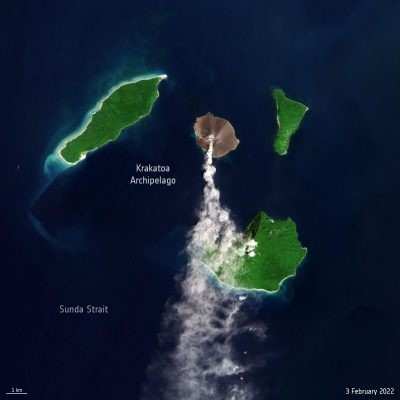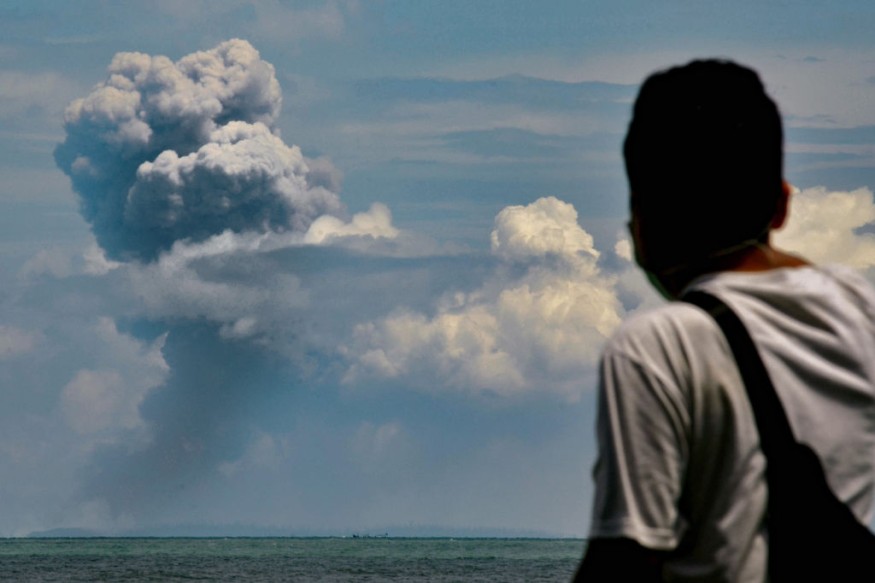Today in Indonesia, the world-famous Krakatoa Volcano erupted. This volcano has substantially influenced global climate since it erupted in 1883. Scientists are keeping an eye on the volcano and telling residents to stay away in the event of a bigger explosion.
The color alert level in the area has been elevated from yellow to orange, according to the Anak Krakatau Volcano Observatory (AKVO). Since the volcanic eruption, Indonesian officials and scientists have used the names Krakatoa and Krakatau.

Current Eruptions
According to the Observatory, the volcano has erupted multiple times, the most recent at 6 p.m. ET today. That eruption lasted around 282 seconds and produced an ash cloud that rose to a height of 5,302 feet in the sky.
"Visuals immediately from the CCT revealed explosions with the color of thick black eruption smoke 1500m from the summit of the volcano," according to Weatherboy, with winds transporting the cloud of volcanic ash to the northeast of the eruption location.
Related Article : USGS Discovers Growing Bulge Near Three Sisters Volcano Due to Increased Seismic Activity
Eruptions Through the Years

An eruption began on May 20, 1883, in the Sunda Strait of Indonesia; the eruption series climax over three months later, on August 27, when the island of Krakatoa and its surrounding archipelago were obliterated when it collapsed into a caldera. The 1883 eruption is thought to have been considerably more powerful than the previous Tonga volcanic explosion at Hunga Tonga, which resulted in a Pacific-wide tsunami and a worldwide pressure wave that circled the Earth many times.
The 1883 eruption was one of the deadliest and most devastating volcanic eruptions ever recorded, wiping out the population of adjacent islands and killing over 35,000 people.
Multiple tsunamis were caused by the volcano disaster, which resulted in pyroclastic flows, copious volcanic ash, and numerous pyroclastic flows. Up to a year after the enormous eruption, there have been several stories of groups of human remains floating across the Indian Ocean and washing up on the east coast of Africa.
While the 1883 Krakatoa eruption was deadly, it had a larger global impact, causing a "volcanic winter," according to scientists. Scientists believe the eruption blasted a massive volume of sulfur dioxide into the stratosphere, which was then carried across the globe by jet streams-this high cloud reflectivity due to a worldwide rise in sulfuric acid content in high-level cirrus clouds.
Because the sun reflected more light into space than usual, the entire planet cooled until the sulfur in the atmosphere precipitated out of the sky over the years.
Global temperatures decreased, and weather patterns shifted in the year after the eruption, resulting in record rainfall in areas like Los Angeles and San Diego and severe snowfall in New York City.
Forecasts

It's too early to tell what Krakatoa's next move will be. The volcano has grown relatively active in recent months. Intermittent white gas and steam plumes would emerge and swirl over the volcano throughout 2021. The NASA Global Sulfur Dioxide Monitoring Page also observed modest but noticeable sulfur dioxide emissions from above the volcano throughout the year.
White plumes and white-to-gray plumes were also spotted rising over Krakatau in November 2021 during periods of clear weather, with incandescence visible inside the crater at least three times. Authorities raised the volcano's alert level to 2 on a scale of 1-2 due to the activity. The public was urged to stay outside a 2 km radius of danger from the volcanic crater, which is still in effect today.
Also Read : Tonga Volcanic Explosion Was Strong Enough to Send Gravitational Waves to the Atmosphere
For similar news, don't forget to follow Nature World News!
© 2026 NatureWorldNews.com All rights reserved. Do not reproduce without permission.





